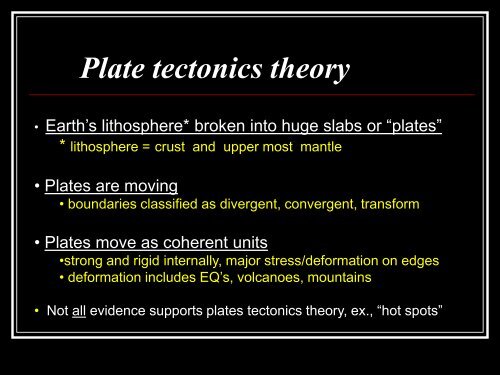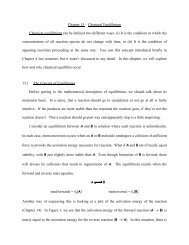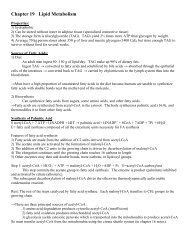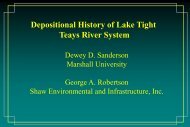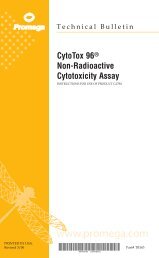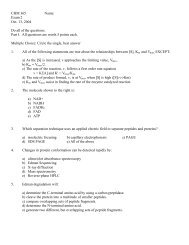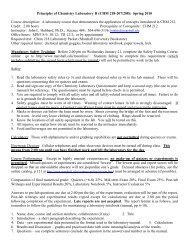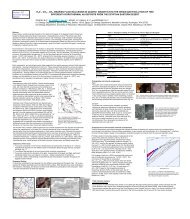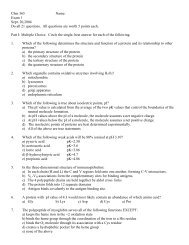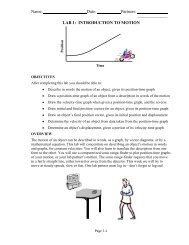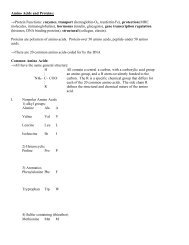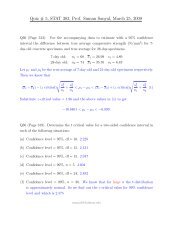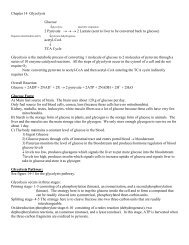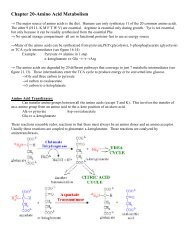Plate tectonics theory
Plate tectonics theory
Plate tectonics theory
Create successful ePaper yourself
Turn your PDF publications into a flip-book with our unique Google optimized e-Paper software.
<strong>Plate</strong> <strong>tectonics</strong> <strong>theory</strong><br />
• Earth’s lithosphere* broken into huge slabs or “plates”<br />
* lithosphere = crust and upper most mantle<br />
• <strong>Plate</strong>s are moving<br />
• boundaries classified as divergent, convergent, transform<br />
• <strong>Plate</strong>s move as coherent units<br />
•strong and rigid internally, major stress/deformation on edges<br />
• deformation includes EQ’s, volcanoes, mountains<br />
• Not all evidence supports plates <strong>tectonics</strong> <strong>theory</strong>, ex., “hot spots”
How did the earth’ s plates<br />
move over geologic time?<br />
See these links for the answer:<br />
http://www.ucmp.berkeley.edu/geology/<strong>tectonics</strong>.html<br />
http://www.odsn.de/odsn/services/paleomap/animation.html
Explaining plate movement<br />
• continental drift “<strong>theory</strong>” (really a hypothesis)<br />
• presented evidence that plates had moved, but could<br />
not explain how.<br />
•Theory lacked a “mechanism” for plate movement.<br />
• modern plate tectonic <strong>theory</strong><br />
• provided mechanism (how) and driving force (why)
Continental Drift Theory / Hypothesis
Other evidence<br />
discussed in text<br />
Continental drift was only one<br />
hypothesis proposed to<br />
explain fossil evidence
Chemically<br />
1. Crust<br />
2. Mantle<br />
3. Core<br />
Physically<br />
1. Lithosphere<br />
2. Asthenosphere<br />
3. Mesosphere
A simple lab model of the earth’s lithosphere
ρ Styrofoam<br />
1.25”<br />
Styrofoam<br />
ρ
Mountains<br />
60-90<br />
miles<br />
~150<br />
miles<br />
Continental<br />
Lithosphere<br />
Ocean Floor<br />
Oceanic<br />
Lithosphere<br />
3 - 60 miles<br />
Asthenosphere
Crust is thin upper “skin” of lithosphere<br />
Mountains<br />
Continental Crust<br />
Asthenosphere<br />
Oceanic<br />
crust
Continental crust is thicker than oceanic crust<br />
Mountains<br />
Continental Crust 40 miles<br />
25 miles<br />
Ocean<br />
Floor<br />
Asthenosphere<br />
5 miles<br />
thick<br />
Oceanic<br />
crust
Continental crust is lighter (less dense)<br />
than oceanic crust<br />
Continental Crust<br />
ρ = 2.7 g/cc<br />
Asthenosphere<br />
ρ = 3.3 g/cc<br />
Oceanic crust<br />
ρ = 3.0 g/cc
Summary: Two types of crust:<br />
Continental<br />
• thicker (25-70 miles), less dense<br />
• rides over top of oceanic crust at convergent boundaries<br />
• different composition than oceanic crust<br />
• Oceanic<br />
• thin (5 miles), more dense<br />
• sinks below continental crust at convergent boundaries<br />
• different composition than cont. crust
Continental margins:<br />
transitions between continental and oceanic crust<br />
Continental Crust<br />
Continental<br />
Margin<br />
Oceanic crust<br />
Asthenosphere
Passive continental margins:<br />
Oceanic and continental crust on same plate,<br />
firmly joined, moving together.<br />
Continental Crust<br />
Continental<br />
Margin<br />
Oceanic crust<br />
Asthenosphere
Passive continental margins:<br />
Oceanic and continental crust on same plate,<br />
firmly joined, moving together<br />
Atlantic Ocean bordered<br />
by two passive margins
Active continental margins:<br />
Oceanic crust and continental on separate plates,<br />
Not joined, and moving relative to each other.<br />
Continental Crust<br />
Continental<br />
Margin<br />
Oceanic crust<br />
Asthenosphere
Active continental margins:<br />
If movement is convergent …<br />
Continental Crust<br />
Continental<br />
Margin<br />
Oceanic crust<br />
Asthenosphere
Subduction ! (C-O)<br />
Causes earthquakes, volcanoes, mountain building
Active continental margins:<br />
Oceanic and continental crust on separate plates,<br />
not joined, and moving relative to each other.
Subduction ! (O-O)<br />
Causes earthquakes, volcanoes, mountain building
Now know of three types of motion at plate boundaries<br />
and two types of crust:<br />
• Convergent<br />
• Divergent<br />
• O-O, C-O, C-C<br />
• O-O, C-C<br />
C = Continental crust<br />
O = Oceanic crust<br />
• Transform<br />
• C-C, O-O, C-O
An oceanic-continental convergent<br />
plate boundary (C-O convergent)<br />
Melting of subducting plate<br />
“destructive boundary”
An oceanic-oceanic convergent plate<br />
boundary (O-O convergent)
A continental-continental convergent<br />
plate boundary (C-C convergent)
Divergent boundaries are located mainly<br />
along oceanic ridges (O-O divergent)<br />
“seafloor spreading”<br />
Creation of new plate<br />
“constructive boundary”
The East African rift – a<br />
divergent boundary on land<br />
(C-C divergent)
A continental-oceanic transform plate<br />
boundary (C-O transform)
Heat flow: driving mechanism<br />
behind plate <strong>tectonics</strong><br />
Sources:<br />
• Residual heat<br />
• Radioactive heat<br />
on ocean floor
Testing <strong>Plate</strong> <strong>tectonics</strong> model<br />
• Paleomagnetic field patterns<br />
on ocean floor<br />
• Hot spots (e.g, Hawaii)


